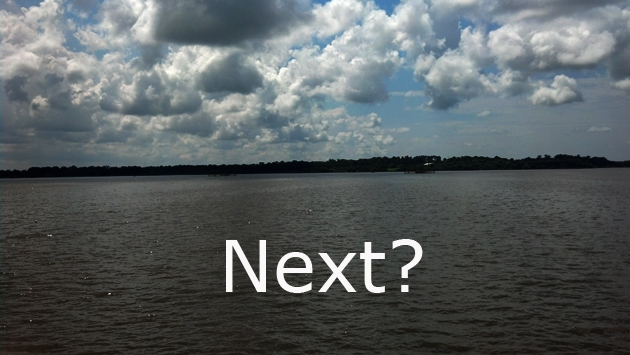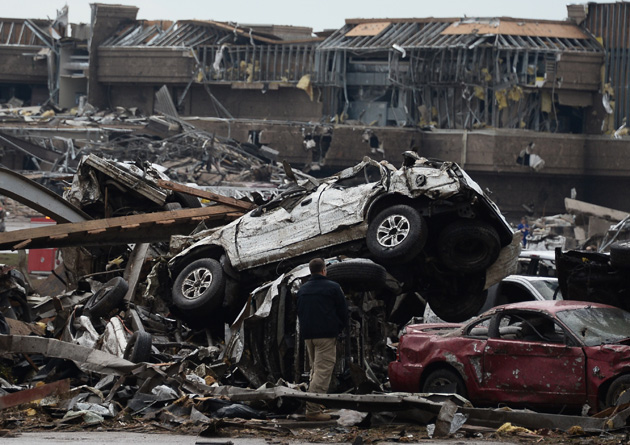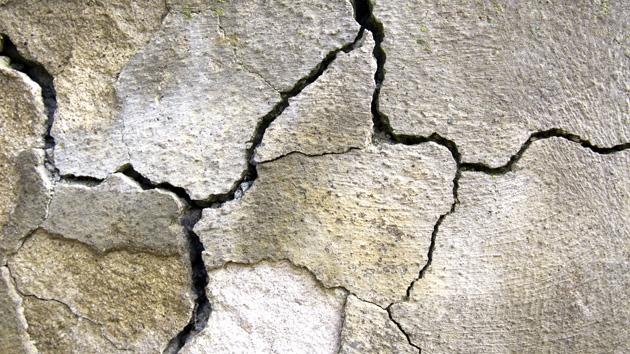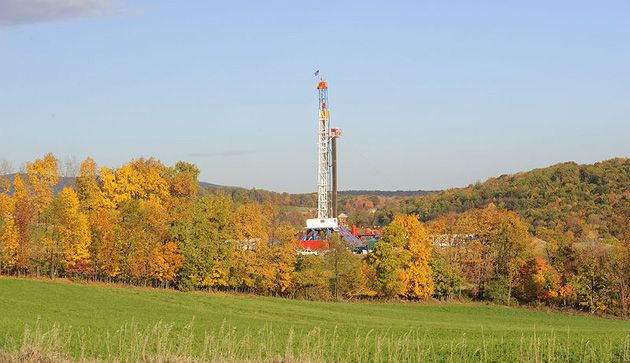About once a month, the residents of Bayou Corne, Louisiana, meet at the Assumption Parish library in the early evening to talk about the hole in their lives. “It was just like going through cancer all over again,” says one. “You fight and you fight and you fight and you think, ‘Doggone it, I’ve beaten this thing,’ and then it’s back.” Another spent last Thanksgiving at a 24-hour washateria because she and her disabled husband had nowhere else to go. As the box of tissues circulates, a third woman confesses that after 20 years of sobriety she recently testified at a public meeting under the influence.
“The God of my understanding says, ‘As you sow, so shall you reap,'” says Kenny Simoneaux, a balding man in a Harley-Davidson T-shirt. He has instructed his grandchildren to lock up the ammunition. “I’m so goddamn mad I could kill somebody.”
But the support group isn’t for addiction, PTSD, or cancer, though all of these maladies are present. The hole in their lives is a literal one. One night in August 2012, after months of unexplained seismic activity and mysterious bubbling on the bayou, a sinkhole opened up on a plot of land leased by the petrochemical company Texas Brine, forcing an immediate evacuation of Bayou Corne’s 350 residents—an exodus that still has no end in sight. Last week, Louisiana filed a lawsuit against the company and the principal landowner, Occidental Chemical Corporation, for damages stemming from the cavern collapse.
Texas Brine’s operation sits atop a three-mile-wide, mile-plus-deep salt deposit known as the Napoleonville Dome, which is sheathed by a layer of oil and natural gas, a common feature of the salt domes prevalent in Gulf Coast states. The company specializes in a process known as injection mining, and it had sunk a series of wells deep into the salt dome, flushing them out with high-pressure streams of freshwater and pumping the resulting saltwater to the surface. From there, the brine is piped and trucked to refineries along the Mississippi River and broken down into sodium hydroxide and chlorine for use in manufacturing everything from paper to medical supplies.
What happened in Bayou Corne, as near as anyone can tell, is that one of the salt caverns Texas Brine hollowed out—a mine dubbed Oxy3—collapsed. The sinkhole initially spanned about an acre. Today it covers more than 24 acres and is an estimated 750 feet deep. It subsists on a diet of swamp life and cypress trees, which it occasionally swallows whole. It celebrated its first birthday recently, and like most one-year-olds, it is both growing and prone to uncontrollable burps, in which a noxious brew of crude oil and rotten debris bubbles to the surface. But the biggest danger is invisible; the collapse unlocked tens of millions of cubic feet of explosive gases, which have seeped into the aquifer and wafted up to the community. The town blames the regulators. The regulators blame Texas Brine. Texas Brine blames some other company, or maybe the regulators, or maybe just God.
Bayou Corne is the biggest ongoing industrial disaster in the United States you haven’t heard of. In addition to creating a massive sinkhole, it has unearthed an uncomfortable truth: Modern mining and drilling techniques are disturbing the geological order in ways that scientists still don’t fully understand. Humans have been extracting natural resources from the earth since the dawn of mankind, but never before at the rate and magnitude of today’s petrochemical industry. And the side effects are becoming clear. It’s not just sinkholes and town-clearing natural gas leaks: Recently, the drilling process known as fracking has been linked to an increased risk of earthquakes.
“When you keep drilling over and over and over again, whether it’s into bedrock or into salt caverns, at some point you have fractured the integrity of this underground structure enough that something is in danger of collapsing,” observes ecologist and author Sandra Steingraber, whose work has focused on fracking and injection wells. “It’s an inherently dangerous situation.”
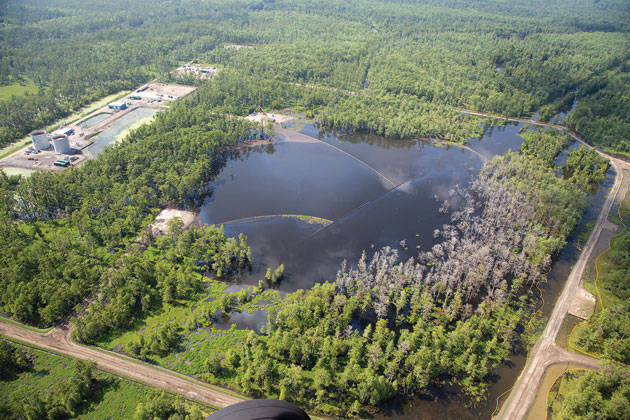
The domes are not just harvested for their salt. Over the last 60 years, in the Gulf Coast—and to a lesser extent in Kansas, Michigan, and New York—industry has increasingly used the sprawling caverns that result from injection mining as a handy place to store things—namely crude oil, pressurized gases, and even radioactive materials. The federal government considers salt tombs in Louisiana and Texas ideal for the US Strategic Petroleum Reserve. The hundreds of salt caverns that honeycomb the substrata, as companies like Texas Brine take pains to point out, are mostly safe, most of the time. But when something goes wrong, the results are disastrous—sometimes spelling the end for nearby communities. The dangers are myriad, from sinkholes to natural gas explosions to toxic-fume releases. Salt caverns account for just 7 percent of all natural gas storage facilities in the United States (although that number is increasing) but 100 percent of all major accidents, according to one industry analyst.
Bayou Corne residents need only drive a quarter mile down Highway 70 to see the worst-case scenario. On Christmas Day 2003, a methane leak from a Napoleonville Dome salt cavern storing natural gas forced residents of Grand Bayou, a neighboring hamlet, to evacuate. Dow Chemical, which owned the cavern, bought out the mostly elderly residents, leaving only concrete slabs behind. In places like Barbers Hill, Texas, similar leaks have turned once-thriving neighborhoods into ghost towns. A 2001 cavern leak in Hutchinson, Kansas, spewed 30-foot-tall geysers of gas and water and caused an explosion that left two people dead.
“I hate to say, but it’s not an unusual event,” says Robert Traylor, a geologist at the Railroad Commission of Texas, the state’s oil and gas regulator. “These things happen. In the oil business, a million things can go wrong, and they usually go wrong.”
But disasters like the one in Bayou Corne have done little to slow the growth of injection mining. Last spring, lawmakers in Baton Rouge pushed through a handful of modest reforms in response to the sinkhole, but the toughest regulations were knocked down by the chemical industry. New caverns continue to be permitted. It’s not a question of whether there will be another Bayou Corne—but where, and how big.
On a scorching June morning, I board a Cessna to survey the sinkhole. My 45-mile flight passes through the heart of southern Louisiana’s industrial jungle, a continuous series of pipelines and processing plants that line the Mississippi as it twists like a busted-up slinky toward the gulf. The smoking skyline gives way to a checkered ribbon of cane and soybean fields and at last to the swampy interior of Assumption Parish.
You notice the booms first, bright yellow plastic rolls designed to trap the oil and brine that collect on the surface and prevent them from seeping into the surrounding waterways. A grove of cypress trees has been stripped bare and sits gray and rotting. At 500 feet, the air is thick with the smell of crude, and the water has a rainbow sheen; in the last few hours, the sinkhole has burped again, and workers are scurrying to contain the new release.
The Acadians—the French Canadian refugees who settled here in the 1700s—were drawn to the bayous by their bounty of gators and crawdads and spoonbills. Petrochemical giants came for other reasons: the chemicals in the salt domes and the oil and gas reserves that surround them. Gas and brine pipelines cross over and under the town and its surrounding swamps, carving up the basin into a web of rights of way for companies including Chevron, Dow, Crosstex, and Florida Gas.
Texas Brine’s Oxy3 cavern, one of 53 in the Napoleonville Dome and one of six operated by the company, is more than a mile below the surface. At that depth, 3-D seismic mapping is both time-consuming and expensive, and as a consequence, injection-mining companies often have only a foggy—and outdated—idea of what their mines really look like. “Everybody wants to do it within a certain budget and a certain time frame,” explains Jim LaMoreaux, a hydrologist who organizes an annual conference on salt-cavern-caused sinkholes. In some cases, he says, it’s possible that companies cut corners and fail to commission the proper studies.
Texas Brine’s first and last mapping project was in 1982, and by the company’s own admission, it understated Oxy3’s proximity to the edge of the salt dome and the possibility of a breach. When another company surveyed the dome a few years ago, it found that Texas Brine’s cavern was less than 100 feet from the outer sheath of oil and gas, far closer than is permitted in other states. While Louisiana had restrictions on gas storage caverns, it had nothing on the books for active brine wells—only what regulators called a “rule of thumb” that wells be set back 200 feet.
When Texas Brine applied for a permit to expand Oxy3 in 2010, the company pressure-tested the cavern as mandated by the state, but it was unable to build up the requisite pressure, let alone sustain it. “At this time, a breach out of the salt dome appears possible,” Mark Cartwright, a Texas Brine executive, notified the state’s Department of Natural Resources. The DNR asked Texas Brine to “plug and abandon” the well. The agency did not, as it sometimes does, request further monitoring. Both parties expected the cavern to hold its shape, and it did until early June 2012, when Gary Metrejean felt the ground shake.

“I didn’t want to say anything because I didn’t want everyone to think I was crazy,” he says. But his neighbors noticed it, too. And they also saw something else unusual—bubbles of gas (“like boiling pasta,” one resident recalls) appearing around the bayou.
Oxy3 was starting to cave in, but at the time the community was at a loss. The state’s experts first suspected a leak from a natural gas pipeline, but that turned up nothing, so they investigated and ruled out the possibility that the bubbling might be “swamp gas”—naturally occurring emissions from decaying plant life. The US Geological Survey confirmed an increase in seismic activity but couldn’t determine its exact source—there are no fault lines in the area. At the end of July 2012, with tremors and bubbling increasing and no clear signs of subsidence, Texas Brine, which had emerged as a possible culprit, told state officials that a sinkhole was highly unlikely.
On August 3, Bayou Corne residents awoke to the smell of sweet crude emanating from a gaping pit on the other side of the highway. Gov. Bobby Jindal issued an evacuation order that afternoon. Texas Brine got a permit to drill a relief well. When the company finally accessed the plugged chamber, they found the outer wall of the salt dome had collapsed. The breach allowed sediment to pour into the cavern, creating a seam through which oil and explosive gases were forced up to the surface.
It has been well established that structurally challenged caverns, owing to a lack of maintenance or poor planning, can cause sinkholes. In 1954, the collapse of a brining cavern at Bayou Choctaw, north of Baton Rouge—located in the same dome that today houses part of the US Strategic Petroleum Reserve—created an 820-foot-wide lake. In 2008, a 150-foot-deep crater known as “Sinkhole de Mayo” opened up over a cavern 50 miles northeast of Houston that had been used for storing oil drilling waste. But those disasters were all due to top-down pressure. Oxy3 collapsed from the side, something regulators and briners had previously considered impossible—highlighting, once again, how poorly understood the geology of salt caverns truly is.
Texas Brine’s official line is that it has no idea why its cavern suddenly gave way; a mess appeared on its property without warning, and it is doing the responsible thing by cleaning it up. Yet it didn’t begin paying buyouts to evacuees until nine months after the collapse, when Jindal threatened to shut down its Louisiana operations if it didn’t. The settlements come with no admission of wrongdoing—to the contrary, the company insists the town is perfectly safe, and that residents (some of whom have defied the evacuation order) are taking advantage of Texas Brine’s generosity by accepting weekly $875 stipends for living expenses while never leaving their homes. Only 59 homeowners have taken deals so far; others have signed onto a class action lawsuit against the company that’s set to go to trial next year. Celebrity activist Erin Brockovich has been shuttling back and forth to Bayou Corne enlisting plaintiffs. “I just don’t think anyone’s gonna live there again,” she says. “And if no one lives there, what desire is there for Texas Brine to clean it up? It’s a tragedy really all the way around.”
I meet Millard Fillmore “Sonny” Cranch, a crisis PR specialist retained by Texas Brine, in a trailer a hundred yards from the edge of the sinkhole. Nearby are two storage silos emblazoned with the company’s slogan, “Texas Brine. Responsible Care.” Cranch is a self-described “old fart” with Harry Potter glasses that wrap around his curly white hair and a habit of pounding the steering wheel when he wants to make a point.
The company’s cleanup crew is rounding the “clubhouse turn,” he explains, and they believe the sediment level in the cavern is stabilizing; the sinkhole may still expand slightly, and the burps might continue, but the worst is in the past. Truth be told, he’s not even sure why the evacuation order is still active, but hey, if there’s a “perceived risk,” then safety first, right? According to Cranch, most of the gas that has been detected in explosive levels under the community is “naturally occurring swamp gas.” (State officials aren’t so sure.) Besides, Cranch tells me, it’s not as if there’s anything particularly menacing about hydrogen sulfide. “Flatulence is H2S,” he says, sensing a chance to lighten the mood. “You’re producing H2S as we speak right now.”
In the car, Cranch says this morning’s burp hadn’t released much oil, but once we get to the site and inhale the fumes, he quickly revises his estimate upward: “I lied—that’s more than five gallons.” While the DNR warns that accurate measurements are difficult, John Boudreaux, the Assumption Parish director of emergency preparedness, told me more than 300 gallons had surfaced. (In July, Boudreaux double-checked the company’s estimate of the sinkhole’s depth—140 feet, Texas Brine claimed—and found that it had understated the figure by a factor of five.)
Given the class action, Texas Brine has a financial interest in deflecting the blame. During our outing, Cranch floats two possible culprits for the sinkhole: an oil well that another company drilled just outside the edge of the dome in the 1950s, or perhaps an earthquake. This isn’t the official Texas Brine position, he’s careful to add—”that’s just Millard Cranch, theorizing.”
The locals find such theories particularly irksome. “They think we’re just a bunch of ignorant coonasses,” says Mike Schaff, who like a few dozen Bayou Corne residents has ignored the evacuation order and stayed in his home. “We may be coonasses—but we’re not ignorant.”
Ignorance, willful or otherwise, is inextricable from what happened in Bayou Corne. Not only do Louisiana regulators have a poor grasp on how miners may be disturbing subsurface geology, they also have a pretty vague sense of how many caverns are located close to the outer ring of salt domes. In January, the Department of Natural Resources ordered companies with salt caverns to provide their most recently updated maps, and the agency is working on rules that would require additional modeling of the 29 caverns that are within 300 feet of an edge. And the agency is proposing regulations mandating that caverns be shut down and monitored for five years, rather than simply plugged and abandoned, if they fail a mechanical integrity test.
That’s a start. But Wilma Subra, a MacArthur “Genius Grant”-winning chemist who advises the Louisiana Environmental Action Network, a group that’s been monitoring the Bayou Corne sinkhole, is dubious that any meaningful action will be taken. “The regulatory climate is such that agencies are only allowed to put forth regulations that the industry supports,” Subra says. Meanwhile, she adds, “What occurred in Bayou Corne shows what could potentially occur in any number of the other salt domes that have storage caverns.”
Just down the road from what’s left of Bayou Corne, the slabs and dead grass of Grand Bayou stand as a warning, albeit one nobody paid much attention to. There’s a road sign on the water’s edge bearing an Oliver Wendell Holmes quote: “Where we love is home—home that our feet may leave but not our hearts.” The sign includes a date to mark the beginning of the settlement. There’s no year of death, but it reads like the town’s tombstone.
Back at the Assumption Parish library, Candy Blanchard has the floor and she’s rolling. The exodus is on everyone’s mind. She and her husband were planning out their retirement in a community their families had called home for generations. “Anybody who stays here and camps here, you gotta wanna be here,” she says. “I mean, it’s not a booming place.” They hunt, they fish, they frog—or they did, anyway. But for the last 10 months, they’ve been crashing with friends in Paincourtville, and her husband has fallen into depression. Every morning, Blanchard, an elementary school teacher, breaks down on her drive to work and collects herself in the parking lot. But there’s something about her odyssey her students seem to grasp immediately. “I taught migration this year,” she tells the sniffling room. “It was the easiest lesson I’ve taught in my entire life.”


